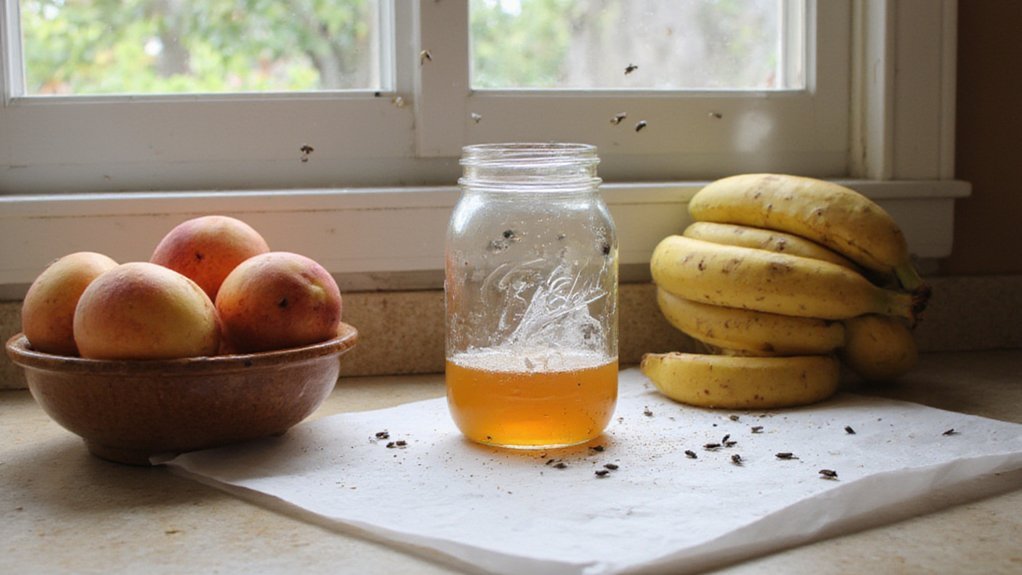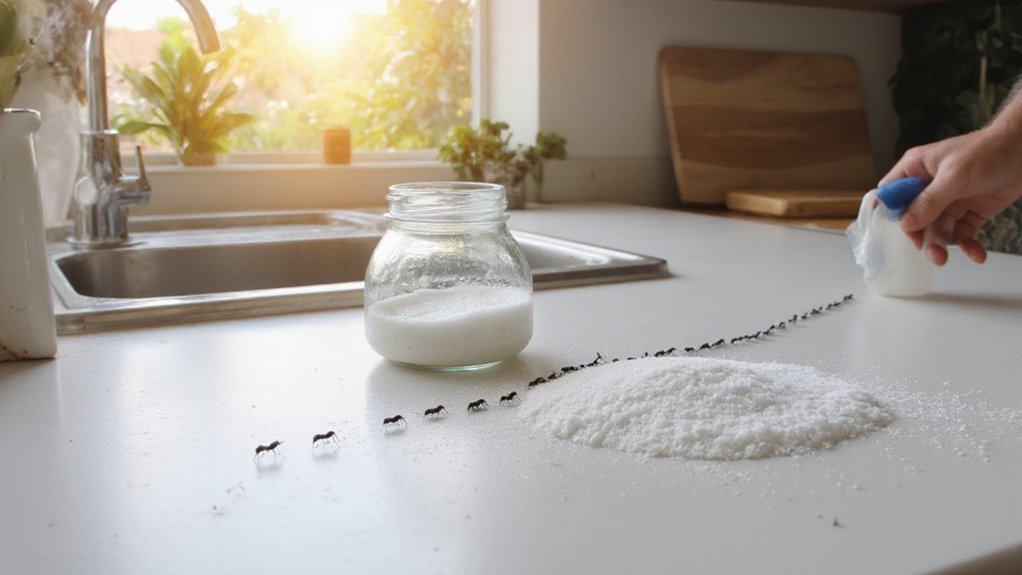You’ve got fruit flies because they find food and moisture; you can get rid of them fast by locating breeding spots, trapping adults, and stopping reproduction at the source. Start by checking produce, drains, trash and houseplants, then set simple vinegar traps and clean thoroughly. Follow a few practical steps and you’ll see results in days — here’s exactly what to do next.
Key Takeaways
- Remove and discard overripe fruit and obvious breeding sites immediately, sealing trash and compost bags.
- Thoroughly clean and sanitize drains, sink traps, and sticky surfaces where larvae and adults congregate.
- Set fast traps: apple cider vinegar with dish soap or a fruit-baited jar with a funnel, replacing bait every 48 hours.
- Empty, wash, and dry recycling, trash bins, and drip trays daily; store produce in sealed containers or the fridge.
- If flies persist after source removal and trapping, contact a pest professional for targeted inspection and treatment.
What Attracts Fruit Flies in Your Home
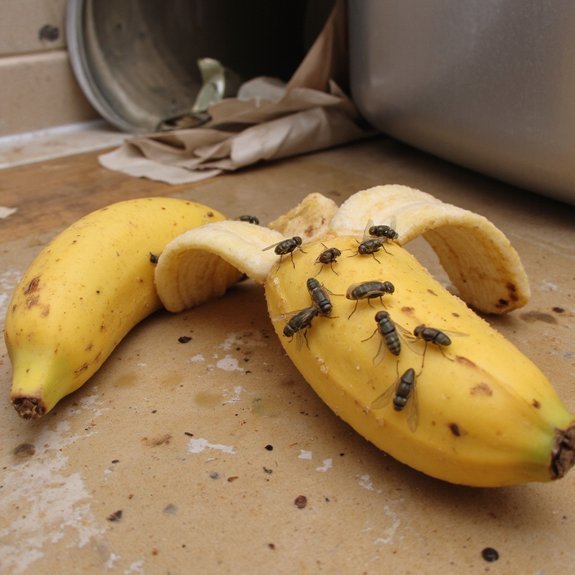
Because fruit flies seek out fermenting sugars and moisture, you’ll notice them where overripe fruit, sticky spills, or damp organic matter sits unattended. You should treat attraction as predictable chemistry: fruit flies follow volatile compounds from ethanol, acetic acid, and yeast activity. Focus on eliminating common food sources like exposed produce, recycling bins, drained residues, and unsealed sauces. They exploit tiny openings and settle quickly when warm temperatures persist, so reduce ambient warmth and airflow that concentrates odors. You can adopt inventive routines: wrap and refrigerate perishables, rinse containers before storage, and schedule waste removal. Use airtight composting or sealed bins and maintain dry sink traps; these practical steps interrupt resources without relying on constant pesticides. You’ll also benefit from monitoring humidity and deploying quick-response traps to lower adult numbers while you change habits. Stay systematic, prioritize source control, and you’ll make infestations far less likely to reoccur.
How to Inspect and Locate Breeding Sites
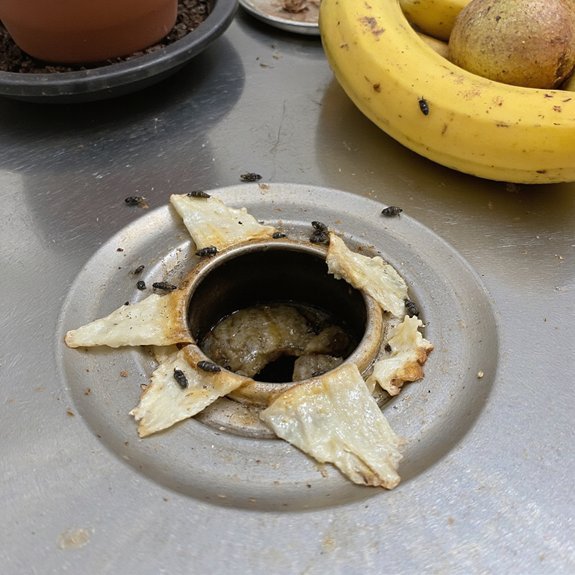
Start with a quick, systematic walkthrough of areas that produce fermenting odors and hold moisture. Check fruit bowls, recycling bins, drains, potted plants, under appliances, and trash areas; fruit fly habitats are often small, hidden, and clustered. Use targeted inspection techniques: shine a flashlight into crevices, lift lids, probe grout lines, and smell for sour fermentation. Pull baseboards and inspect beneath mulch in houseplants; damp organic matter is prime. Look for larvae—tiny, pale, and wriggling—around drains and decaying produce. Map hotspots as you go, noting frequency and conditions that support breeding. You’ll want to inspect at different times, especially evenings when activity peaks. Record findings on a simple checklist so you can prioritize interventions. If you can’t locate a source after thorough inspection techniques, expand to building drains, sewer lines, or neighboring units. Be methodical, persistent, and data-driven to eliminate the habitats feeding the infestation now.
Quick Homemade Traps That Work
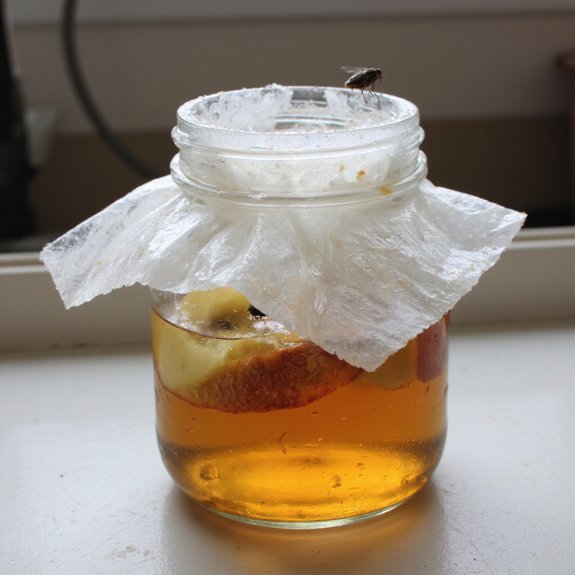
Set up a few simple, proven traps you can make in minutes to cut fruit fly numbers fast: a small jar with apple cider vinegar and a drop of dish soap (or a few smashed wine/beer droplets) covered with plastic wrap punctured with holes, a paper cone funnel baited with ripe fruit in a jar, or sticky strips near breeding hotspots. Use the vinegar trap in kitchens its smell draws flies; soap breaks tension so they drown. For capture rates, combine a paper cone and fruit bait—place ripe banana pieces below the funnel and seal the rim so flies enter but can’t exit. Swap baits every 48 hours, empty and sanitize containers to avoid rebreeding. Position traps low and near sources you identified earlier. Innovate by varying bait blends and trap placement, but prioritize cleanliness. These quick homemade solutions give rapid pressure while you eliminate breeding sites now.
Using Store-Bought Traps and Sprays Safely
Choose EPA-approved traps and sprays so you’re using products proven safe and effective. Read and follow label directions exactly for dosage, placement, and disposal to avoid mistakes. Keep sprays and sticky traps out of reach of children and pets, and ventilate the area until fumes clear.
Choose Epa-Approved Products
When you pick store-bought traps or sprays, prioritize EPA-approved products and follow their labels exactly to protect your household and the environment. Choose EPA approved insecticides with low toxicity profiles and documented efficacy for Drosophila species. If you prefer lighter options, look for certified organic fruit fly control formulations or botanical-based baits that target breeding sites without harmful residues. Verify registration numbers and manufacturer credentials, and opt for products designed for indoor use when treating kitchens and pantries. Combine traps and targeted treatments strategically to interrupt life cycles rapidly. Store products safely, out of reach of children and pets. Dispose of spent traps and containers per local waste guidelines to minimize environmental impact. Consider integrated tools that use monitoring, attraction, and precise removal today.
Follow Label Directions
Before you apply any trap or spray, read and follow the product label exactly — it’s the law and the safest way to get effective results. You’ll get predictable outcomes when you follow label directions; labels tell you dose, placement, frequency and disposal to maximize product safety and efficacy. Treat labels as design specs for pest control innovation.
- Note active ingredients and targets.
- Apply only at recommended rates and intervals.
- Use specified placement to optimize lure and trap performance.
- Dispose and recycle according to instructions.
Follow label directions to iterate quickly: test, measure, adjust within labeled limits. That disciplined approach reduces mistakes, preserves efficacy, and lets you adopt better tactics fast. Document results and refine methods, integrating smarter tools and data-driven adjustments for continuous improvement.
Protect People and Pets
Protect household members and pets by treating traps and sprays as potentially hazardous tools that need extra safeguards beyond label instructions. You’ll keep kids and animals safe by placing traps out of reach, using enclosed units, and choosing low-toxicity options. When spraying, ventilate, wear gloves, and avoid treating surfaces pets contact. Combine store-bought tools with natural repellents like vinegar traps or essential oils to reduce chemical exposure. Monitor treated zones daily and remove spent baits. For pet safety, store products locked and follow emergency label instructions. If exposure occurs, contact poison control and your veterinarian immediately. Iterate solutions; prioritize humane, low-risk methods.
| Item | Placement | Action |
|---|---|---|
| Trap | Out of reach | Check daily |
| Spray | Ventilated area | Avoid pet surfaces |
| Repellent | Non-toxic option | Test small area |
Cleaning and Sanitizing to Stop Reproduction
Eliminate breeding sites by thoroughly cleaning and sanitizing any place that holds food residue or moisture—drains, garbage cans, recycling bins, fruit bowls, sticky countertops and under appliances. You’ll stop fruit flies by focusing on sanitizing surfaces and removing waste, then maintaining a routine that prevents eggs and larvae.
- Clear and discard overripe produce; store fresh items in sealed containers or the fridge.
- Wipe counters and shelves with a vinegar or mild bleach solution; let surfaces dry completely.
- Empty and wash recycling and trash receptacles regularly; line them with clean bags.
- Inspect and clean under and behind appliances; use compressed air or pull units when practical.
Adopt a schedule: quick daily wipes, weekly deep-cleaning, and immediate spill response. You’ll reduce attraction points, interrupt reproduction cycles, and create an environment hostile to reinfestation. Keep documentation of tasks if you’re optimizing protocols or scaling up.
Dealing With Drains, Garbage Disposals, and Sinks
Once you’ve removed exposed food and sanitized surfaces, turn your attention to drains, garbage disposals, and sink traps, which harbor organic buildup and fly larvae. Inspect and run water, then use a stiff brush or pipe brush to dislodge gunk; enzymatic cleaners speed decomposition without harsh fumes. For disposal maintenance, grind citrus peels with ice to scrape walls and flush with hot water. Remove and clean sink stoppers; check P-traps for residue. Schedule routine drain cleaning—enzymes weekly, mechanical cleaning monthly—to interrupt breeding cycles. Seal overflow openings and repair slow drains; fruit flies exploit standing moisture. Use a flashlight to confirm cleanliness and rerun treatments until no larvae appear. The table below gives concise actions and frequency.
| Action | Frequency |
|---|---|
| Enzymatic cleaner | Weekly |
| Mechanical brush | Monthly |
| Citrus + ice | Weekly |
| P-trap inspection | Monthly |
| Seal/repair drains | As needed |
Maintain records of drain cleaning and disposal maintenance to track progress and improvements.
Managing Indoor Plants and Compost Bins
While indoor plants and countertop compost bins add life to your home, they also attract fruit flies if you don’t control moisture and decaying material. You can manage plant pests and compost maintenance with targeted, innovative steps that cut breeding sites and keep soils and bins healthy. Act quickly, inspect regularly, and use low-tech traps or well-chosen amendments.
- Remove overripe material: scoop decaying scraps from compost bins daily and seal or process them.
- Optimize moisture: keep potting mix damp, not wet; let the top inch dry to deter larvae.
- Improve airflow: use aerated compost containers and elevate pots to reduce stagnant humidity.
- Biological control: introduce beneficial nematodes or predatory mites selectively to combat plant pests.
Focus on data-driven tweaks: sensor watering, sealed compost cycles, and minimal organic residues. You’ll reduce flies while preserving the benefits of plants and indoor compost. Measure results and adapt.
Preventive Habits to Keep Fruit Flies Away
You can stop fruit flies before they arrive with three simple daily habits. Wipe up spills and sticky residues immediately, store produce sealed or in the fridge, and empty trash and compost bins frequently. If you do these consistently, you’ll cut off breeding sites and drastically reduce infestations.
Clean up Spills Promptly
Promptly clean any spills—especially sugary or fermented liquids—because fruit flies are drawn to even small residues and will lay eggs there within hours. You must treat spillage clean up as a routine, applying prompt action to prevent breeding hotspots. Use quick, tech-enabled tools and simple disinfectants to remove residues; don’t let crumbs or sticky streaks accumulate. Follow these steps:
- Wipe spills immediately with paper towel, then sanitize the area.
- Use a microfiber cloth and eco-friendly cleanser for corners and crevices.
- Empty and clean drip trays, recyclables, and bottle caps daily.
- Implement short, scheduled checks after meals and deliveries.
Stay disciplined: consistent, innovative habits stop infestations before they start. Adopt these measures now, iterate improvements, and you’ll reduce fly populations reliably and measurably starting today.
Store Produce Properly
Storage: keep ripe fruit in the refrigerator and unripe fruit in a cool, ventilated spot, and don’t leave cut or overripe pieces exposed where flies can land. You’ll adopt proper storage habits to block fruit fly access and extend shelf life through smart fruit preservation.
| Item | Tip |
|---|---|
| Ripe berries | Refrigerate in sealed container |
| Bananas | Wrap stems; keep separate |
| Cut fruit | Use airtight wrap |
| On-the-counter | Rotate, inspect daily |
Label and date containers, use breathable produce bags for unripe items, and inspect often. These practical, innovative steps reduce attraction and waste. Create a weekly inventory, prioritize first-in-first-out, embrace airtight modular containers, and integrate humidity-controlled drawers or smart sensors to monitor ripeness—small investments that elevate fruit preservation and cut infestation risk considerably for long-term control and resilience.
Empty Bins Frequently
Keeping produce sealed and refrigerated reduces attraction, but full trash or compost bins will still draw fruit flies. You should empty bins frequently and adopt simple bin maintenance to interrupt the fruit fly lifecycle before larvae develop. Emptying prevents eggs, reduces odors, and limits breeding sites.
- Schedule daily or every-other-day emptying for food waste.
- Rinse containers and wipe lids to remove residues.
- Use sealed liners and clean bin interiors weekly with vinegar solution.
- Store compost outdoors or in sealed tumblers until pickup.
These steps are practical and scalable; they fit busy, innovation-minded kitchens. You’ll cut reproductive cycles, reduce visits from adults, and make other control methods far more effective. Track results and tweak frequency to optimize outcomes quickly starting today.
When to Call a Professional Exterminator
If you’ve tried traps, thorough cleaning, and DIY treatments and fruit flies keep coming back, call a professional exterminator. You’ll know it’s time when infestations persist despite sanitation, when flies appear across multiple rooms, or when they return within days of treatment. Seek professional assistance that uses targeted inspection, source tracing, and low-toxicity strategies tailored to your space. Ask prospective companies about integrated pest control plans, guarantees, and data-driven methods—drone or sensor assessments can be available in innovative firms. Expect a scoped quote, timeline, and follow-up protocol; demand documentation of chemicals, safety measures, and waste handling. If you lease, inform your property manager and insist on coordinated action. Don’t delay if you run a business: infestations quickly harm reputation and compliance. A prompt, tech-forward exterminator will stop recurrence, safeguard your environment, and restore normal operations with measurable results. Schedule an assessment to regain control and peace of mind.
Tips for Protecting Produce and Reducing Waste
After a professional inspection stops an active infestation, you’ll want to protect produce and cut waste to prevent a comeback. Adopt streamlined produce storage and smart waste management so you don’t reintroduce flies. Seal ripe fruit in breathable containers, refrigerate what will last, and inspect bins daily. Innovate by rotating stock with clear labeling and app reminders to eat or freeze items before spoilage.
- Store produce in sealed or breathable tech-enabled containers to extend life.
- Compost responsibly in sealed outdoor bins and empty indoor scraps frequently.
- Use clear-first-out organization and digital timers to reduce overripe fruit.
- Sanitize collection areas weekly and repair gaps that invite pests.
You’ll reduce attractants, lower waste, and make your kitchen inhospitable to fruit flies. These practical, modern habits lock in inspection gains and prevent repeat infestations. Keep monitoring for two weeks and adjust storage protocols as needed to maintain a pest-free environment.
